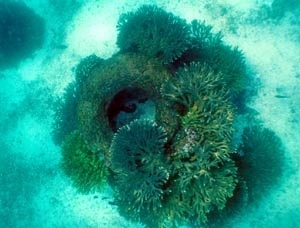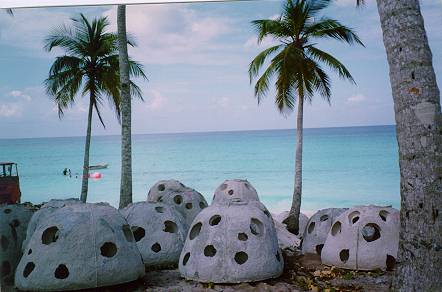The positive impacts of reef balls
By Jon Dorsey, RJD Intern
It is evident that the ocean’s conditions are changing at alarming rates due to natural disasters and man’s activities. Pressures such as global warming, hurricanes and boat groundings all increase the environmental and physical stresses on delicate coral reefs. As a consequence of these increases pressured, coral reefs are rapidly reducing in size. After witnessing the destruction of the corals reefs off Grand Cayman after a hurricane passed through, Todd Barber founded the Reef Ball Foundation in 1993. Originally this foundation was focused on building these structures solely for coral reef restoration, but their innovative design has opened doors to many other types of restoration projects such as oyster reefs, mangrove plantings, and even beach erosion control.
Reef Balls come in over 10 sizes and have 20 different styles due to their multipurpose usage. The basic reef restoration Reef Ball is a hollow semicircle with an opening at the top and is made out of a special concrete that has been estimated to last up to 500 years in the water. They were engineered to withstand the chemical and physical elements of the ocean. Wave tank testing has indicated that they are stable enough to not overturn in rough waters due to their sponge-like design. This design not only allows the kinetic waters to go through the holes in the side, lowering the pressure being put on the outer walls, and displaces water out of the top as a sponge does through their operculum, but the design also allows for the cycling of nutrients over the whole surface area of the Reef Ball. Minuscule currents push the nutrient rich ocean waters around the inner and outer areas of the reef ball, providing nourishment for all the growing coral. The concrete walls have a rough surface texture to enhance coral settlement by trapping the larvae in grooves or crevices. All these independent physical factors have added to the increasing global success of the reef balls. Proof of their success is in the fact that the Reef Ball Foundation has deployed coral reef nurturing sites in over 59 countries.

Caption: Reef Balls out on the Dominican Republic beach waiting to be sunk. All rights to this picture belong to the Reed Ball Foundation at www.reefball.org
Other than providing an ideal developing site for coral reefs, Reefs balls have been shown to offer a stable home for oyster farms and mangrove plantings. Oyster populations along the east coast of the United States have been dwindling and are now only a fraction of what they were only 20 years ago. Oyster farmers are having a tough time meeting the necessary quota for the market, and the solution for some of these farmers are Reef Balls. The Reef Balls provide a steady support for the growing oysters in the shallow waters in which they are found. Not only are oysters economically important, their environmental niche is to act as a water purifier. An individual oyster can filter up to 20 gallons of water in one hour, so the depletion of these species would result in the eutrophication of shallow local waters, which inevitably would restrict the amount of life found in that area (Gaurier, et al. 2011). Reef Balls typically yield 100% coverage by oysters as a result of concrete made with a pH that is suitable for oyster larvae to attach. Typical concrete has a pH close to 12, but this specialized concrete mixed with microsilica has a pH close to 8.3 which is much closer to the pH of natural sea water.
Mangroves are also another critical species that are showing positive growth due to Reef Balls. Mangroves are a type of endangered tree that inhabit fringe areas between fresh and salt water systems. Global declines of mangrove forests have been shown to be up to 4 times that of land forest depletion (Sjoling, et al. 2005). Mangroves aid in filtering land runoff from entering the ocean, provide a safe nursery ground for juvenile species, and help buffer wave action which stabilizes shoreline sediments. For these reasons, it is essential to help mangroves turn around their declining numbers. The Reef Ball Foundation has engineered a Mangrove Planting System that aids the direct planting of the plant’s propagules. The design specializes in promoting growth in high wave energy areas and creates a durable anchoring system. Along with that, it provides the tree with sufficient non-competitive space so the plant can focus on growth rather than ways to move around blockades from other plants’ roots or buried debris. Although this is a new field for the Reef Ball Foundation, promising results are coming from Mangrove plantings in Antigua and Grand Cayman.

Caption: Clear results from a Reef Ball that has been sunk for about a year. All rights to this picture belong to the Reef Ball Foundation at www.reefball.org
In sandy locations where mangroves are not found, beach erosion is a perpetual problem. Beaches are constantly getting worn away due to continuous wave action and tidal currents. To maintain sand retention and lower the risk of currents for eco-tourism hot spots, Reef Balls are also a solution. Along the southern shore of the Dominican Republic near Bayahibe, about 450 Reef Balls are set up along the beach to act as a submerged breakwater. To demonstrate the Reef Ball’s effectiveness and endurance, the Dominican Republic beach shortly after installation, in 1993, was hit by Hurricanes Georges and there was no after effect from the hurricane. The beach itself appeared to be untouched, as well as the beaches surrounding. Besides the fact that the Reef Balls successful acted as breakwaters, not a single Reef Ball was damaged or displaced (Torres, et al. 2001).
Reef Balls have demonstrated an outstanding ability to serve multiple purposes in aiding the development of different species. Thanks to their ingenious designs, coral reefs, mangroves, oysters, and many other species have a chance to turn around their declining populations trends to achieve ecological success. Through the implication of more Reef Balls in critical areas, it could be possible to save these species. Along with the nurturing, Reef Balls also play a role in protecting beaches from erosion. The Reef Balls control the amount of wave action and currents, so many ecotourism sites can really benefit from the predictable beach conditions. The Reef Ball Foundation has developed into a promising program will hopefully maintain continual success.
REFERENCES
Sjoling, S., et al.”Benthic Bacterial Diversity and Nutrient Processes in Mangroves: Impact of Deforestation.” Estuarine, Coastal and Shelf Science 63.3 (2005): 397- 406. Print.
Gaurier, Benoît, et al. “Experimental and Numerical Characterization of an Oyster Farm Impact on the Flow.” European Journal of Mechanics – B/Fluids 3.5 (2011): 513-25. Print.
Torres, Ruben, et al. “Sedimentation as an Important Environmental Influence on Dominican Republic Reefs.” Bulletin of Marine Science 69.2 (2001): 805-18. Print.




The Reef Balls with coral pictured on this page are clear results…but represent closer to 5-6 years of growth (not one year). Otherwise, very nice article.